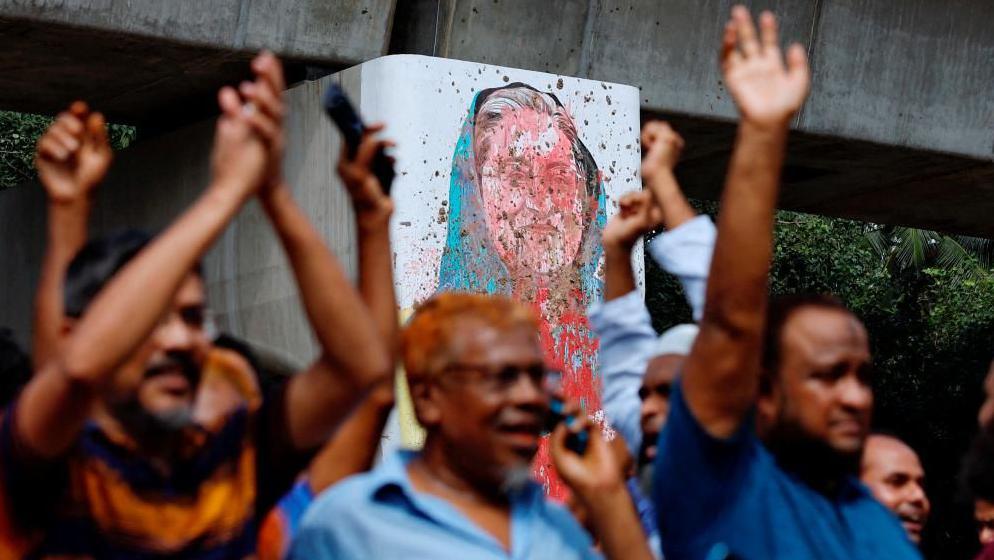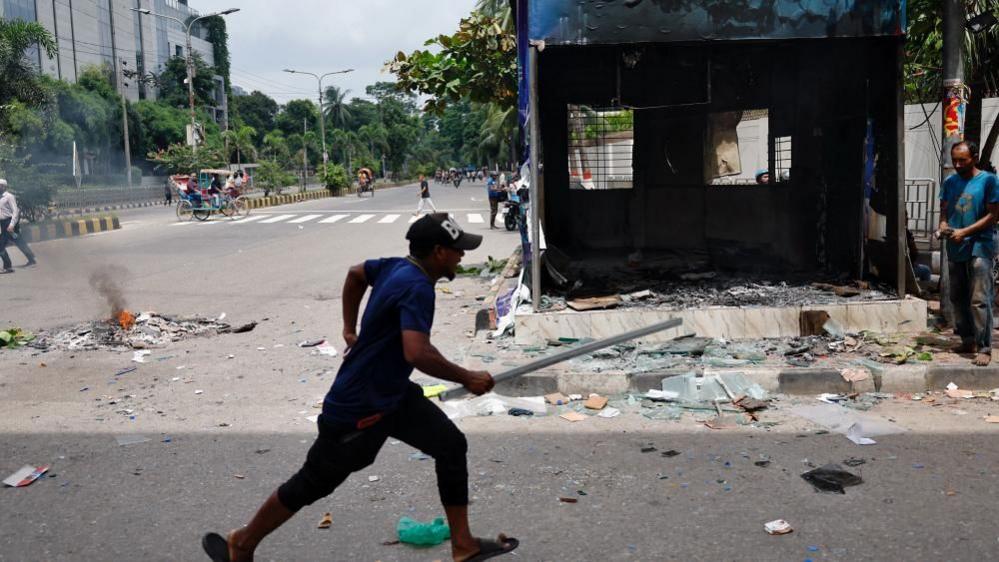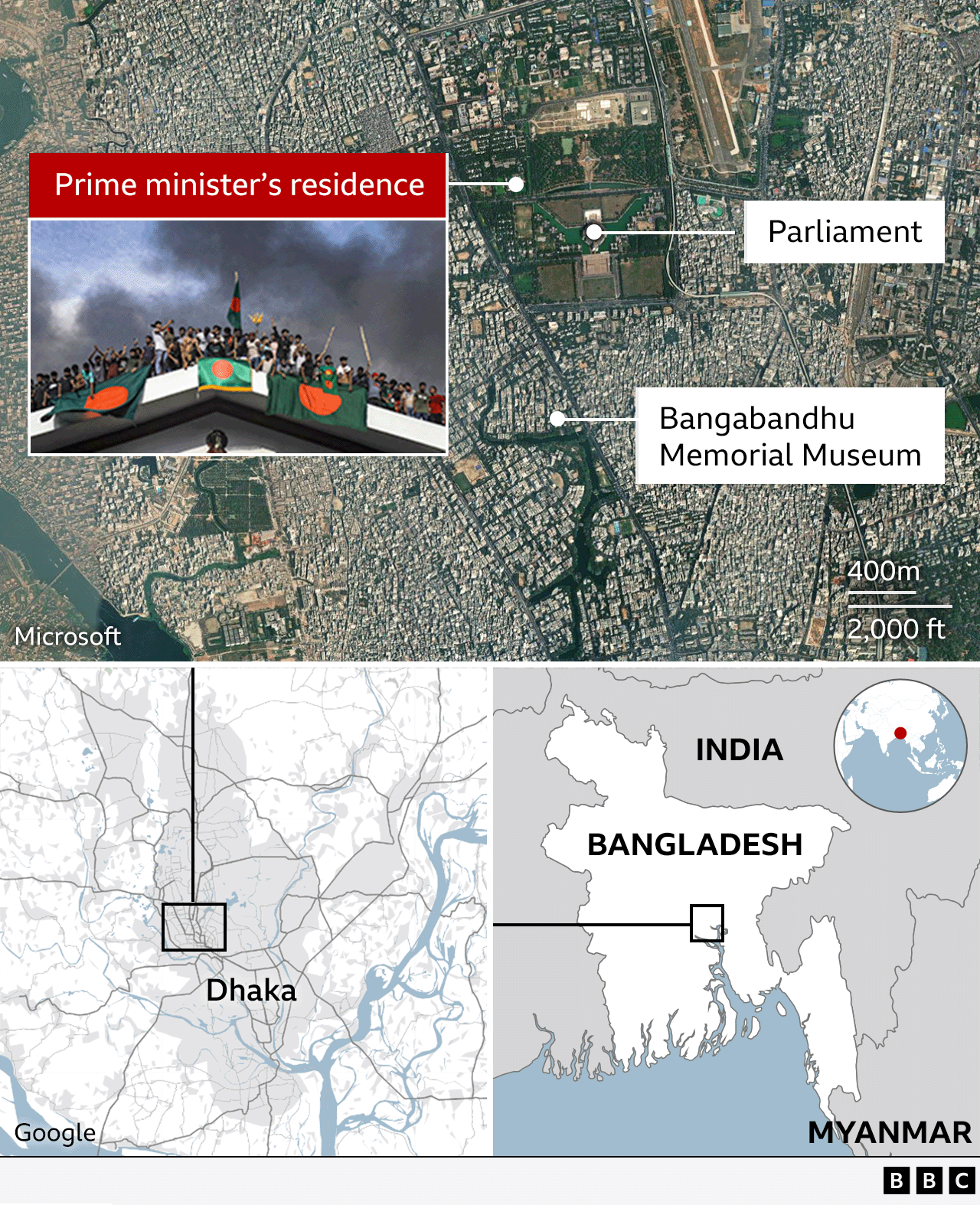Sheikh Hasina's final hours as a hated autocrat

Opponents of Sheikh Hasina cheer in front of a defaced mural of her in Dhaka
- Published
When Sheikh Hasina called crisis security talks to put down spiralling unrest in Bangladesh on Sunday, she appears to have been in denial that her time was up as prime minister.
Within hours, she would be swept away by people power – indeed, few could have predicted the speed of her exit.
In the end, it was the advice of close family rather than top security officials that persuaded her to flee, the BBC was told by her son.
Ms Hasina made her mind up just in time - crowds entered her residence within a couple of hours of her escaping.
Watch: Bangladesh protesters storm prime minister's palace
The National Security Committee meeting - called for late on Sunday morning - brought the embattled prime minister together with the country's top three military chiefs, senior security officials and police. The mood was sober.
Pressure on the prime minister had been mounting for weeks as anti-government protests raged around the country. Hundreds have been killed in the worst violence Bangladesh has seen since its war of independence in 1971.
On Sunday alone, at least 90 people lost their lives, mostly demonstrators shot by security forces - but also a growing number of police killed by the crowds.
BBC Bangla has learned from officials that Sheikh Hasina wanted to keep "two options" open. While there were preparations for her to leave the country, she wanted to stay in power until the last moment - by force.
Military leaders did not agree. On Sunday, ordinary people and protesters mingled with field-level soldiers and army officers in various parts of the country. After reviewing the situation, senior military officers realised things were out of control.
Individually, the military top brass at the meeting told the prime minister that soldiers could not shoot at civilians - but they could provide security back-up to police, sources told the BBC. Senior police chiefs also complained they were running out of ammunition, it later emerged.
"Police were exhausted. We heard that they didn’t have adequate ammunition," retired Brigadier General M Sakhawat Hussain told the BBC.
Sheikh Hasina, however, would not listen - and no-one was willing to disagree with her to her face.
After the meeting, she delivered her defiant message. She called the protesters "terrorists" and urged people to resist those she described as "arsonists".
Security forces feared they could soon have a situation approaching civil war on their hands.

Violence escalated on Sunday - here, a protester runs near a vandalised police box in Dhaka
Pictures of Sunday's violence were going viral on social media as the death toll steadily rose. Images of young men with bullet wounds, shot by police and members of the ruling Awami League party's youth wing, were triggering more anger.
As the ferocity of the clashes became clear, student leaders brought forward their call for a mass march on Dhaka by a day, taking the authorities by surprise.
Intelligence inputs suggested the students' demands were gaining traction and thousands of people were planning to descend on the capital the following day.
If the security forces tried to stop the protesters, there would be another bloodbath.
So army chief Waker-Uz-Zaman decided to speak to the prime minister again.
Reliable sources said the three service chiefs met her on Sunday evening and politely explained that the situation on the ground was getting more and more volatile, and that crowds of thousands were expected in Dhaka on Monday morning. They could not guarantee the safety of her residence.
Sheikh Hasina did not take their advice, but journalists in Dhaka said they could sense power was already shifting. By Sunday night, police were absent in many places and numerous security barricades were unmanned.
“She was adamant, neither would she resign nor was she willing to leave. The three chiefs came, and they tried to make her understand about what’s happening on the ground," Gen Hussain said.
"They said it would be difficult for the troops to fire on the crowd. They said our troops are also part of the country. They come from villages, they would not open fire on their own people.”
What sparked the protests that toppled Bangladesh's PM?
- Published6 August 2024
The Nobel winner tasked with leading a nation out of chaos
- Published7 August 2024

On Monday morning, large crowds had started moving towards Dhaka. Gen Zaman was at Ms Hasina's residence once again explaining to her the gravity of the situation. People were breaking the curfew and violence had already started.
Police were being withdrawn from many parts of Dhaka and Gen Zaman told her they could not prevent the crowd from reaching Gono Bhaban, the PM's official residence in the capital, for much longer. An hour or so at best.
At this point, military chiefs decided to call on family members to intercede.
Police and military chiefs then held talks with Sheikh Hasina's sister, Rehana Siddiq, to see if she could persuade her elder sibling to leave.
"The officials held discussions with Sheikh Rehana in another room. They asked her to explain the situation to Sheikh Hasina. Sheikh Rehana then talked with her elder sister, but Sheikh Hasina was determined to hold on to power," the Bengali-language Prothom Alo daily said.
Then Ms Hasina's son Sajeeb and daughter Saima, who both live abroad, spoke to her on the phone and insisted she should go. During these family negotiations, the army chief, who is related to Ms Hasina by marriage, was reportedly present throughout.
"My mum did not wish to leave the country at all. We had to persuade her," Sajeeb Wazed Joy told the BBC on Tuesday, adding his mother began thinking of resigning on Saturday evening.
"We in the family begged her, we urged her, this is the mob, they are out for violence and they will kill you and we need to get you to safety. Only however long it took the mob to get there, that was how much time she had. They just left without any preparation.
"I rang her yesterday in Delhi. She's in good spirits but she's very disappointed. She's very disheartened by the people of Bangladesh."

People walk next to vandalised cars at a police station in Dhaka on Tuesday
On Monday morning, sources said, Sheikh Hasina got in touch with government officials in Delhi to request sanctuary. The advice from India, a staunch ally throughout her long career, was for her to leave.
A day earlier, Washington had reportedly been telling Indian foreign ministry officials that time was up for Ms Hasina. She had run out of options.
“She resigned when she realised that the army was not supporting her," M Sakhawat Hussain, the retired brigadier general, said. "People were about to break the curfew and were gathering in Dhaka to march towards her residence.”
But once Sheikh Hasina reluctantly agreed to sign documents relinquishing her post, there was still the question of how to get her out of the country safely.
A senior military official, who did not wish to be named, told BBC Bangla that only the Special Security Force, the Presidential Guard Regiment and some senior military officers at army headquarters knew when Sheikh Hasina signed the resignation letter and boarded the military helicopter that would fly her out of her residence. The whole thing was done quite secretly.
At about 10:30 local time (05:00GMT), the authorities shut down the internet so that no news about Sheikh Hasina's movements could spread on social media.
It was only reactivated after she had made her getaway.
According to senior army sources, arrangements were put in place to get Sheikh Hasina to the airport safely. There were concerns her convoy might be attacked, so the entire route was cleared and the departure point secured. But in the end, it was not safe to take her by road, so a helicopter was used instead.
Right up to the moment of departure, Sheikh Hasina was reluctant to get on it, her son said.
“She wanted my aunt to leave," her son said. "My mother did not want to get on the helicopter. I was on the call, persuading my mother, telling my aunt, both of them that she had to leave.”
Once they did, they were flown from Gono Bhaban to a waiting Bangladeshi Air Force C-130 Hercules aircraft that had been made ready.
Sajeeb Wazed Joy says he believes they went to Agartala, the capital of India's eastern state of Tripura and were flown from there to Delhi. India had already been approached and agreed her transit via this route, officials said.
Other accounts say she was taken by helicopter to an airport in Dhaka, then by plane to Delhi.
Whichever route they took, at about 13:30 local time, Ms Hasina and her sister were transferred from the helicopter to the aircraft that took them to Delhi, officials said.
A video on social media showed four or five suitcases on the ground waiting to be loaded. Many of the things she left behind were being carted off by crowds who invaded her residence, even as she was still in the air.
Several hours later, the aircraft landed in Delhi, its passengers' onward destination unclear.
Back in Dhaka, the internet was back on and all around Bangladesh, celebrations were breaking out marking the end of Sheikh Hasina's 15-year rule.
A woman once viewed as a democrat but later reviled by many as a despot had fled like a fugitive under cover of internet darkness.
This story was updated on 15 August to reflect new information that senior Awami League MP, Salman Fazlur Rahman, was not on the helicopter